 I sleep with old sneakers and work gloves under my bed. My house and car are stocked with hand-crank radios, potable water and archaic, shelf-stable foodstuffs like hardtack and jerky. In my closet there is a crowbar and a very large axe, which I will use, should an earthquake tumble the walls, to excavate through the rubble to my son in the next room. And also because large axes are very cool.
I sleep with old sneakers and work gloves under my bed. My house and car are stocked with hand-crank radios, potable water and archaic, shelf-stable foodstuffs like hardtack and jerky. In my closet there is a crowbar and a very large axe, which I will use, should an earthquake tumble the walls, to excavate through the rubble to my son in the next room. And also because large axes are very cool.
I live in California, within a few miles of the San Andreas Fault. And I’m nowhere near ready for when the big one comes.
Sadly, the same thing seems to have been true for Christchurch, a gem of a city on New Zealand’s South Island. When a 6.3 magnitude earthquake hit there at 12:51 pm on February 22, local time, buildings crumbled, communication broke down and at least 166 people died.
Perhaps more surprisingly, two weeks after the quake, many people in the area, especially in the eastern suburbs, are still struggling. Not Haiti 2010 struggling, thank goodness, nor even post-Katrina New Orleans struggling. But still, with water, food and information all in short supply, the question has to be asked: If even Christchurch, the very opposite of a basket case city, can’t handle a relatively small seismic event any better than this, is earthquake “preparedness” even possible?
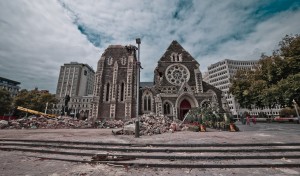 The first time I visited, Christchurch reminded me of a cleaner, more orderly Vancouver. Or perhaps a less dour Zurich.* The Central Business District, with its meandering river, charming square and gingerbread-castle cathedral certainly looks—looked—as though it had been gently transferred from the face of a postcard. But even the outlying areas, while often modest, hardly put one in mind of great poverty or dysfunction. I spent a long night in some of the hardest-hit areas back in 1997. I went out looking for punk rock, got lost and found a truly magnificent restaurant-pub somewhere very near what would become the epicenter of the 2011 quake, along the punishingly long, stumbling hike back to Lyttleton harbor.
The first time I visited, Christchurch reminded me of a cleaner, more orderly Vancouver. Or perhaps a less dour Zurich.* The Central Business District, with its meandering river, charming square and gingerbread-castle cathedral certainly looks—looked—as though it had been gently transferred from the face of a postcard. But even the outlying areas, while often modest, hardly put one in mind of great poverty or dysfunction. I spent a long night in some of the hardest-hit areas back in 1997. I went out looking for punk rock, got lost and found a truly magnificent restaurant-pub somewhere very near what would become the epicenter of the 2011 quake, along the punishingly long, stumbling hike back to Lyttleton harbor.
If there had been brigands, I would have been set upon—heck, if there had been potholes, I wouldn’t have made it home. But the place was dripping with a tidy civic-mindedness, held together with sensible infrastructure. And that’s why Peter Hyde scares me.
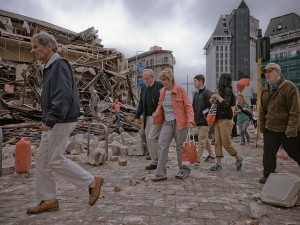 Hyde is a web developer and blogger in those hard-hit eastern suburbs. And on March 2, a full week after the quake, he wrote a sobering analysis of the rescue and recovery efforts to that date. Christchurch had effectively become three cities, he said. Shower City, those areas where water and electricity availability made hot showers possible, accounted for perhaps 65% of the population. The central Rescue City—the post-card areas—suffered most of the deaths and worst destruction. And even though almost no one actually lives there, says Hyde, it also received most of the aid and nearly all of the media coverage—“almost all our knowledge of it comes from media,” he writes, “and man is it a honey-pot for them!”
Hyde is a web developer and blogger in those hard-hit eastern suburbs. And on March 2, a full week after the quake, he wrote a sobering analysis of the rescue and recovery efforts to that date. Christchurch had effectively become three cities, he said. Shower City, those areas where water and electricity availability made hot showers possible, accounted for perhaps 65% of the population. The central Rescue City—the post-card areas—suffered most of the deaths and worst destruction. And even though almost no one actually lives there, says Hyde, it also received most of the aid and nearly all of the media coverage—“almost all our knowledge of it comes from media,” he writes, “and man is it a honey-pot for them!”
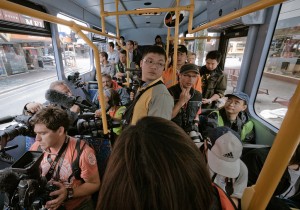
And then there’s Refugee City, mostly in the eastern suburbs, and according to Hyde, sorely neglected. “The resources and attention which are seemingly being poured into [Rescue City] right now are NOT addressing the most urgent post-quake needs of the population of Christchurch,” he writes. Maybe it’s just my own visions of some local earthquake in the too-near future, but I think his description is worth quoting at length:
“Only half of those who remain [in the eastern suburbs]… have power, and almost NONE have running water … Their houses may or may not be intact. Their streets may be clear, broken, or full of silt. Or sewage. There are no showers. Or ways to wash clothes. Or to wash dishes. Or to heat the “must boil” water that is available — assuming they can make it to the nearest water truck, day after day. No refrigeration. No working toilets, and precious few portaloos … The media flies over, drives past and dips into Refugee City, usually at the main welfare or water points. But they don’t cover it that much. From my observations, the officials – those who are making decisions about the relief effort – seem to do likewise.”
Again, not the vision of hell we often see after major disasters — something closer to a really lousy camping trip, perhaps — but still a long way from what residents of a wealthy, educated country with a small population, impressive social cohesion and a great deal of technological and logistical know-how might have expected. Above all, it seems to be a vision of missing or missed communication—and that seems to be the common thread in virtually all disaster response efforts.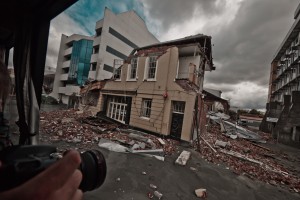
Hyde’s posts on the aftermath came to me the way I get all my good earthquake and tsunami info, through Vassar College geophysicist Brian McAdoo. McAdoo is the kind of globetrotting, do-gooding, adventure-having scientist who can make you feel wan and listless by comparison, just from reading his academic papers. His Tsunami Project blog is the first place I check when the ground starts shaking anywhere other than under my own feet.
He suggests that even in Christchurch, as in Haiti, and Indonesia after the Indian Ocean tsunami, and other places he has worked, the true risk in a disaster is marginalization. “Marginalization yields vulnerability,” he wrote in a Skype chat after we had each put children to bed last night. (Not all adventures happen in exotic locales.) “When you and I were in Chch, we wouldn’t have seen the marginalized places. It could be religious, racial, economic, political …”
Or in Hyde’s case, it could even be geographical—as in too far away from the TV cameras, in his relatively affluent but remote suburb, to attract attention. The marginalization might even be self-inflicted to an extent, in a particularly ironic way. In a recent email message, Hyde told me that authorities relied on calls to a helpline to guide their assistance efforts. “When you are doing what you’ve been told—hunkering down for the first 3 days or so, looking after yourself and your family—you do not place calls to the helpline. You know they will be overwhelmed with people more in need and situations more urgent than your own.”
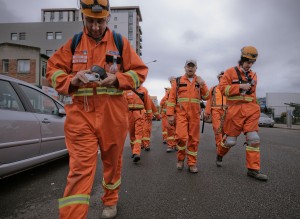 Simply because he and his neighbors had prepared for an earthquake, he suggests, they became less likely to get aid once it hit. It’s discouraging to think that being a little less prepared, and a little less considerate of others in greater need, might have been the smarter survival strategy. “By now, two weeks on,” Hyde writes, “they all know they have a major job on their hands out east, and are finally starting to do simple/obvious thing like redistribute portaloos in line with the most acute need.”
Simply because he and his neighbors had prepared for an earthquake, he suggests, they became less likely to get aid once it hit. It’s discouraging to think that being a little less prepared, and a little less considerate of others in greater need, might have been the smarter survival strategy. “By now, two weeks on,” Hyde writes, “they all know they have a major job on their hands out east, and are finally starting to do simple/obvious thing like redistribute portaloos in line with the most acute need.”
This makes me feel rather smug about the latrine seat I have that can snap on to a five-gallon pail—and really, really bad about the deep, abiding lack of civic-mindedness that surrounds us. It also makes me think of all the things I haven’t yet done to prepare not just for the geological worst, but for the logistical, disaster-aid worst as well. There is something about the inevitability of earthquakes and their infrequency that numbs fear and slows action. But somehow the discomfort of Hyde and his neighbors brings the need to resist the seductive comfort of familiarity home to me much more forcefully that have the much more catastrophic disasters we’ve seen in recent years. It’s just that now I’m not sure whether I should be planning for 168 hours of self sufficiency rather than the recommended 72, or simply moving to more stable ground—geological or otherwise.
—
*I’ve never been to Switzerland, so this is a disappointingly cheap use of one-dimensional cultural stereotypes. Sorry.
—
Credits Photo of central Christchurch moments after the February 22 earthquake, showing clouds of dust and debris from the destruction. Photographer unknown—please help me identify him or her so I can give proper credit. Remaining photos generously supplied by filmmaker and photographer Logan McMillan, whose video of the moments immediately after the quake is also not to be missed.
Alas, we will learn more about the futility of disaster preparedness after Sendai
Thanks for this eloquent discussion.
Looking from a distance, it seems that in northern Japan we can witness – on a tremendous scale – the same basic inadequacies of civic response that I observed on the ground in Christchurch – while all attention is focused on (admittedly grave in this case) headline grabbing issues of human drama and damaged infrastructure.
But it cannot be naivety that explains the failure in Christchurch to offer basic help to the most vulnerable (and, by a coincidence that’s not a coincidence, most affected) citizens. It was obvious to anyone who cared to think about it for a microsecond – let alone those whose job it is to think about it – that people in particular suburbs would be in fairly critical need. Yet nothing was done: tremendous human resources went into cleaning up bourgeois neighbourhoods, and into rebuilding roads, while matters such providing sanitation and clean water to those unable to source them were consciously ignored.
Sure, no Haiti, and certainly no Sendai, but as you say, you’d kind of hope for better from a society like NZ’s – especially as the scale of need was by no means overwhelming.
On the ground, it was interesting to observe how social/economic mobility kicked in: within a few days or a week, the more enfranchised neighbourhoods became quite efficiently self-reliant, while the disenfranchised areas remained largely bereft of the information/cultural capital/financial resources to begin to help themselves.
Thanks again for your writing.
It’s really very sad to see theses kinds of things happening in Haiti, Japan, and others countries. There are many sad stories. We known that the natural phenomenons happen but we are never prepared when such things happen.
Thanks for the information,
Cheers,
Anette.